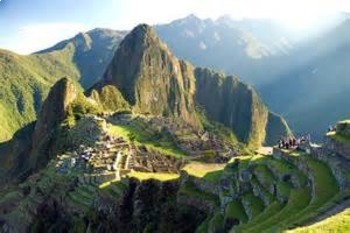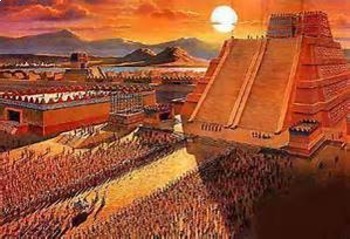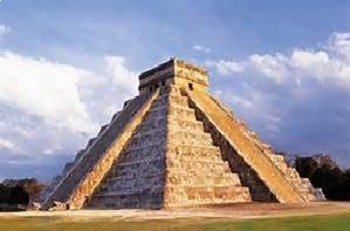Bundle of 4 - Civilizations of the Americas - Mesoamerica
- Zip
Products in this Bundle (4)
Description
This is a bundle of 4, highly animated, power point presentations on Civilizations of the Americas - The First Americans, The Mayans, The Incas and the Aztecs. The four presentations together number 70 slides. Each of the presentation slides are editable so you can change it to fit your individual needs.
Many historians believe that the first settlers of the Americas arrived from Asia across a land bridge that formed in the Bering Strait during the last Ice Age. These first inhabitants were hunters and gatherers who later learned to farm.
The varied geography resulted in the emergence of many distinct cultures. In North America, these early inhabitants included the Inuit people near the Arctic Circle, the Anasazi people of the Southwest, the Hopewell peoples of the Ohio River valley, and the Iroquois of the Northeast.
Mesoamerica, the areas of Mexico and Central America that were civilized before the arrival of the Spaniards around 1200 B.C. with the Olmecs. The most advanced were those of the Maya and the Aztec.
Mayan civilization flourished between 300 and 900 AD. The Maya built splendid temples and pyramids and had a sophisticated calendar. By the 12th century, the Aztec had begun to migrate to the Valley of Mexico. The Aztec built temples and pyramids as well as roads made of stone. They controlled many semi-independent territories.
Power point presentation #1 is titled, Civilizations of the Americas - The First Americans contains 17 slides and covers the following:
First North Americans
People of North America
The Inuit
The Anasazi
The Hopewell
The Iroquois
First Mesoamerican’s
The Spaniards
First South Americans
The Spanish
The Inca
The Maya
The Maya Today
The Aztecs
End of Presentation
The Maya Empire, centered in the tropical lowlands of what is now Guatemala, reached the peak of its power and influence around the 6th century AD. The Maya excelled at agriculture, pottery, hieroglyph writing, calendar-making and mathematics, and left behind an astonishing amount of impressive architecture and symbolic artwork.
Most of the great stone cities of the Maya were abandoned by AD 900. Since the 19th century scholars have debated what might have caused this dramatic decline. Some believe that by the 9th century the Maya had exhausted the environment around them to the point that it could no longer sustain a very large population. Other scholars argue that constant warfare among competing city-states led the complicated military, family and trade alliances between them to break down. Finally, some catastrophic environmental change–like an extremely long, intense period of drought–may have wiped out the Classic Maya civilization.
Power point presentation #2 is titled, Civilizations of the Americas - The Mayans contains 21 slides and covers the following:
Introduction
Map of the Mayan Civilization
Locating the Maya
Classic Period
Early Maya: 1800BC-250AD
Construction
Golden Age: AD 250-900
Maya Life
Religion & Culture
Temples, Math & Astronomy
Peaceful People?
Maya Writings
Life in the Rain Forrest
Natural Resources
Decline of the Maya
Theories of Decline
Catastrophic Event?
Final Collapse
End of Presentation
The Aztecs, who probably originated as a nomadic tribe in northern Mexico, arrived in Mesoamerica around the beginning of the 13th century. From their magnificent capital city, Tenochtitlan, the Aztecs emerged as the dominant force in central Mexico, developing an intricate social, political, religious and commercial organization that brought many of the region’s city-states under their control by the 15th century.
Invaders led by the Spanish conquistador Hernan Cortes overthrew the Aztecs by force and captured Tenochtitlan in 1521, bringing an end to Mesoamerica’s last great native civilization.
Many people in Mexico today can trace their ancestry and some culture back to the Aztec civilization, including the language of the empire Nahuatl which is still spoken. If you visit the country today, you'll see a lot of relics of Aztec culture there, including elaborate stone architecture, pottery, jewelry, paintings and more. Place names, religion - even ways of thinking that were seen in the Aztec civilization are still very much a part of Mexico today.
Power point presentation #3 is titled, Civilizations of the Americas - The Aztecs contains 16 slides and covers the following:
Introduction
Map of the Aztec Empire
Early Aztec History
1325 AD
Aztec Empire Established
Montezuma I
Aztec Society
Aztec Religion
Spanish Invasion
Hernan Cortes
Cortez’s Army Arrives
Spanish Massacre
Remnants of the Aztecs
End of Presentation
The Inca first appeared in the Andes region during the 12th century AD and gradually built a massive kingdom through the military strength of their emperors. Known as Tawantinsuyu, the Inca state spanned the distance of northern Ecuador to central Chile and consisted of 12 million inhabitants from more than 100 different ethnic groups at its peak.
They developed a well-devised agricultural and roadway systems, along with a centralized religion and language. The Inca were quickly overwhelmed by the diseases and superior weaponry of Spanish invaders, ending their once powerful in 1572.
As the only written accounts of the Inca were composed by outsiders, its mythology and culture passed to successive generations by trained storytellers. Traces of its existence were mainly found in the ruins of cities and temples, but in 1911 archaeologist Hiram Bingham discovered the intact 15th century mountaintop citadel of Machu Picchu.
Power point presentation #4 is titled, Civilizations of the Americas - The Incas contains 16 slides and covers the following:
Introduction
Map of the Inca Civilization
Origin Myth
Expansion Begins
Pachacuti Inca Yupanqui
Yupanqui’s Leadership
Inca Life
Religion & The Sacred
Further Expansion
The Spanish Arrive
Francisco Pizarro
Last Stronghold
Machu Picchu
End of Presentation
This is one of many bundled power point presentations I offer in my store under the heading....Civilizations of the Americas.





